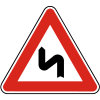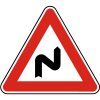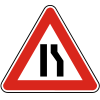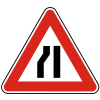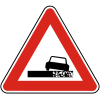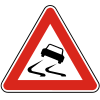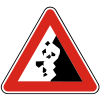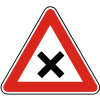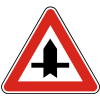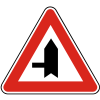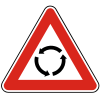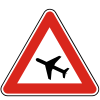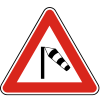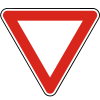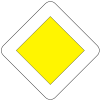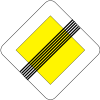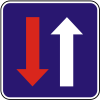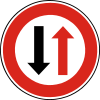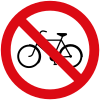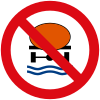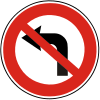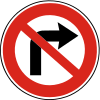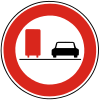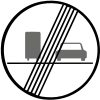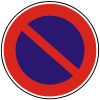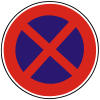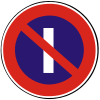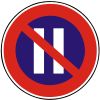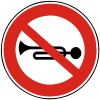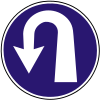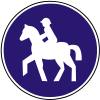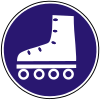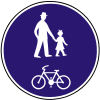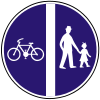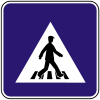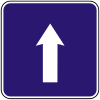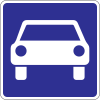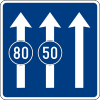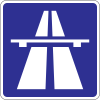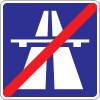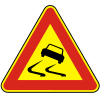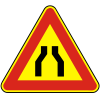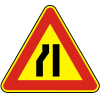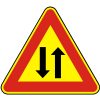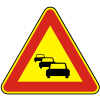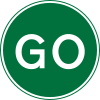
Road signs in Iceland are visual communication devices placed along roads and highways throughout the country to provide information, warnings, and guidance to motorists and pedestrians. Iceland never ratified the Vienna Convention on Road Signs and Signals, but road signs in Iceland conform to the general pattern of those used in most other European countries, with certain design elements borrowed from Danish and Swedish practice. Signs tend to be more sparsely employed than in other European countries, especially in rural areas.

Road signs in Israel are regulated by the Ministry of Transportation in the Division of Transportation Planning, most recently set forth in June 2011.
Road signs in Ukraine are governed by a combination of standards set out by the Vienna Convention on Road Signs and Signals, the European Union (EU), and Ukraine Transport and Roads Agency. Ukrainian signs are similar to the signs of other post-Soviet states and are set out in 7 separate categories based on meaning: warning, priority, prohibitory, mandatory, information, service, and additional plates.
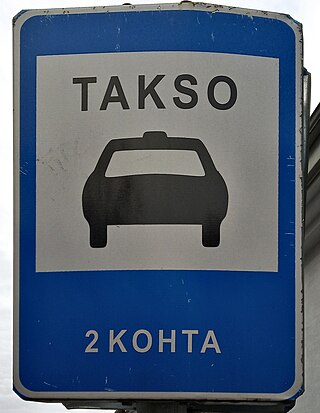
Road signs in Estonia ensure that transport vehicles move safely and orderly, as well as to inform the participants of traffic built-in graphic icons. These icons are governed by the Vienna Convention on Road Traffic and Vienna Convention on Road Signs and Signals. The system is covered in Liiklusmärkide ja teemärgiste tähendused ning nõuded fooridele and the standards document EVS 613:2001 Traffic signs.

Bosnia and Herzegovina is a signatory to the Vienna Convention on Road Signs and Signals. Therefore, road signs do not differ much from the rest of Europe, such as Croatia, Slovenia, Serbia and North Macedonia. Ministry of Transportation of Bosnia and Herzegovina regulates them. Bosnia and Herzegovina drives on the right as with the rest of Europe, except for Cyprus, Ireland, Malta and the United Kingdom. Bosnian and Herzegovinan road signs have two scripts, Latin and Cyrillic script.

Road signs in Cambodia are standardized road signs are similar to those used in Europe but much of it resembles road signage systems used in South American countries with certain differences. The designs of road signage match their neighbours of Thailand and Malaysia, both of which adopt a modified version of the South American road signage system. Until the early 1980s, Cambodia closely followed American, European, Australian, and Japanese practices in road sign design, with diamond-shaped warning signs and circular restrictive signs to regulate traffic. Unlike Thailand and Malaysia, Cambodia does not use the FHWA Series fonts typeface, favouring Helvetica instead.
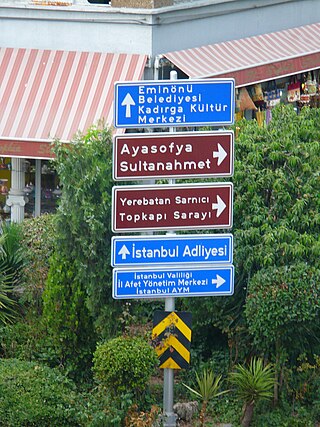
Road signs in Turkey conform to the general pattern of those used in most other European countries and set out in the Vienna Convention on Road Signs and Signals. They are regulated by the Trafik İşaretleri Elkitabi.

Road signs in Azerbaijan are similar to the road sign system of post-Soviet states that ensure that transport vehicles move safely and orderly, as well as to inform the participants of traffic built-in graphic icons. They generally conform to the Vienna Convention on Road Traffic and Vienna Convention on Road Signs and Signals.
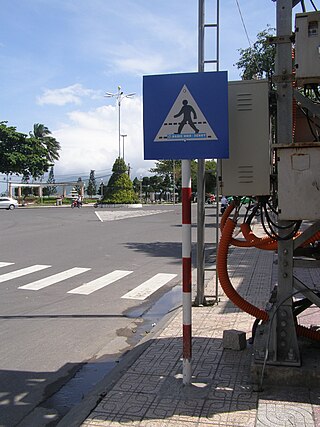
Road signs in Vietnam follow Chinese and French road signs. Some signs are written in both Vietnamese and English. The signs are prescribed by the Ministry of Transportation of Vietnam.

Road signs in Armenia are similar to the signs of other post-Soviet states and most European road sign systems. Armenia is a signatory of the Vienna Convention on Road Traffic and the Vienna Convention on Road Signs and Signals. The Ministry of Transport regulates these icons, while the police enforces them. Road signs ensure transport vehicles move safely and orderly, as well as, to inform both pedestrians and motorists of traffic rules.

Road signs in Georgia are similar to the road sign system of other post-Soviet states that ensure that transport vehicles move safely and orderly, as well as to inform the participants of traffic built-in graphic icons. However, some road signs look a bit different from Soviet ones and closer to the European ones. These icons are governed by the Vienna Convention on Road Traffic and Vienna Convention on Road Signs and Signals.

Road signs in United Arab Emirates are modelled on the British road sign system that are regulated by the Roads and Transport Authority (RTA) Dubai and Department of Transport (DoT) Abu Dhabi. The English language typeface is Transport and the Arabic language typeface is Naskh.

Road signs in Kyrgyzstan are similar to the road sign system of other post-Soviet states that ensure that transport vehicles move safely and orderly, as well as to inform the participants of traffic built-in graphic icons. These icons are governed by the Vienna Convention on Road Traffic and Vienna Convention on Road Signs and Signals.

Road signs in Lithuania conform to the general pattern of those used in most other European countries as set out in the 1968 Vienna Convention on Road Signs and Signals. Due to the country being occupied and annexed by the Soviet Union between 1940 and 1990, when it restored its independence, modern road signs used in Lithuania are in many ways similar in design to road signs used in the Soviet Union before its dissolution in 1991. This design of road signs is still used in most post-Soviet states, in particular Russia, Belarus, and Ukraine. Neighboring post-Soviet Baltic countries Latvia and Estonia, which were also occupied by the Soviet Union in 1940, have significantly modified their road sign designs, resulting road signs in these two countries being extremely different in design from road signs used in most other post-Soviet states.

The road signs, used on the Serbian road network, are regulated by the "Regulation of Traffic Signs", which was last time modified in 2017.

Road signs in Portugal are governed by the "Regulamento de Sinalização do Trânsito" of the Republic of Portugal.
Road signs in Latvia conform to the general pattern of those used in most other European countries. They are regulated in Ceļu satiksmes noteikumi and the standards documents LVS 77–1:2016 "Ceļa zīmes. 1. daļa: Ceļa zīmes", LVS 77-2:2016 "Ceļa zīmes. 2. daļa: Uzstādīšanas noteikumi" and LVS 77-3:2016 "Ceļa zīmes. 3. daļa: Tehniskās prasības" in conformity with the 1968 Vienna Convention on Road Signs and Signals. Latvia acceded to the Vienna Convention on Road Signs and Signals on October 19, 1992.

Road signs in South Africa are based on the SADC-Road Traffic Sign Manual, a document designed to harmonise traffic signs in member states of the Southern Africa Development Community. Most of these signs were in the preceding South African RTSM.

Road signs in Hungary are regulated in KRESZ. KRESZ is a collection of rules contained in a decree, legally known as 1/1975. KPM-BM joint decree, which "regulates traffic on public roads in Hungary and on private roads not closed to public traffic". Since 1988, the most basic rules of traffic have been contained in Act I of 1988 on road traffic. The rules of KRESZ are in many respects similar or identical to the rules of most countries with public transport. Road signs generally conform to the 1968 Vienna Convention on Road Signs and Signals and the European Agreement supplementing it, as well as their amendments that came into force in 1995.
Road signs in Angola are heavily modelled on road signs in Portugal, since Angola is a former Portuguese colony. They are regulated in Código de Estrada and conform to the general pattern of road signs as set out in the Vienna Convention on Road Signs and Signals. Despite this, Angola is not a signatory to this convention, but Portugal is.



